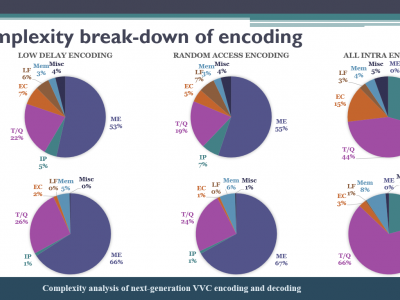Documents
Presentation Slides
Complexity Analysis Of Next-Generation VVC Encoding and Decoding

- Citation Author(s):
- Submitted by:
- Farhad Pakdaman
- Last updated:
- 19 November 2020 - 3:11pm
- Document Type:
- Presentation Slides
- Document Year:
- 2020
- Event:
- Presenters:
- Farhad Pakdaman
- Paper Code:
- 1833
- Categories:
- Log in to post comments
While the next generation video compression standard, Versatile Video Coding (VVC), provides a superior compression efficiency, its computational complexity dramatically increases. This paper thoroughly analyzes this complexity for both encoder and decoder of VVC Test Model 6, by quantifying the complexity break-down for each coding tool and measuring the complexity and memory requirements for VVC encoding/decoding. These extensive analyses are performed for six video sequences of 720p, 1080p, and 2160p, under Low-Delay (LD), Random-Access (RA), and All-Intra (AI) conditions (a total of 320 encoding/decoding). Results indicate that the VVC encoder and decoder are 5x and 1.5x more complex compared to HEVC in LD, and 31x and 1.8x in AI, respectively. Detailed analysis of coding tools reveals that in LD on average, motion estimation tools with 53%, transformation and quantization with 22%, and entropy coding with 7% dominate the encoding complexity. In decoding, loop filters with 30%, motion compensation with 20%, and entropy decoding with 16%, are the most complex modules. Moreover, the required memory bandwidth for VVC encoding/decoding are measured through memory profiling, which are 30x and 3x of HEVC. The reported results and insights are a guide for future research and implementations of energy-efficient VVC encoder/decoder.

